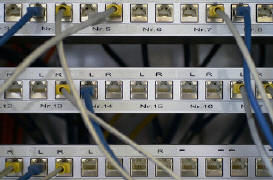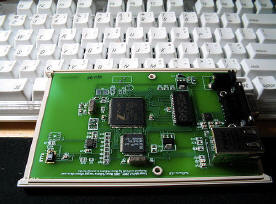IP Convergence
Definition: IP Convergence implies the carriage of different types of traffic such as voice, video,
data, and images over a single network. The integrated network is based on the Internet Protocol (IP).
What is IP Convergence?
Corporate managements have long desired a single network that would allow them to transfer both
voice and data. Timely information is now a key asset and corporates realize the importance of
investing in networks that facilitate enterprise telecommunications. Enterprise networks that are
based on the Internet Protocol network technology are today in the forefront of answering businessesí
requirement for a useful and cost-effective network that can serve as the backbone for all enterprise
communication needs. Along with meeting the challenges posed by the physical integration of the network,
it is also important to ensure that the aggregated flow of traffic meets the quality and functionality
requirements as fulfilled by the discrete networks.
 The core aspects that dictate the implementation and
deployment of an IP convergent network
include integrating discrete network elements; staying up-to-date with IP and its associated protocols;
and having systems in place to manage voice, data, and video traffic for multimedia applications. The core aspects that dictate the implementation and
deployment of an IP convergent network
include integrating discrete network elements; staying up-to-date with IP and its associated protocols;
and having systems in place to manage voice, data, and video traffic for multimedia applications.
The benefits of IP Convergence
1. Excellent support for multimedia applications. Improved connectivity means that devices
can be assigned specific tasks; the number of devices required is less which makes installation,
deployment, and
learning an easier task.
2. A converged IP network is a single platform on which interoperable devices can be run in
innovative ways. Since IP is an open standard, it is vendor independent and this helps in
fostering interoperability and improving network efficiency in terms of time and cost. The
ambit of IP convergence encompasses networks, devices, and different technologies and systems
that can be operated on a unified
infrastructure.
3. A converged IP network is easier to manage because of the uniform setup in which the system
resources operate.
Training users is easy.
4. An enterprise can achieve flexibility in terms of moulding its communication patterns to its
management practices. This is a dynamic process that can be continually improved with collaboration
from network partners. What this results in is the right information to the right person at the right
time leading to improved decision making.
5. IP networks have proven to be remarkably scalable and this has been one of the prime reasons
that even large enterprises have gone ahead with implementing IP. Applications that run on IP
networks are available all over the world; in fact most new business applications include inbuilt IP support.
6. An IP convergent network is capable of making use of the developments in class of service
differentiation and QoS-based routing. This leads to better utilization of resources and also
allows for capacity redundancy to take care of an increase in the number of users.
7. A uniform environment requires fewer components in the network. Smoother maintenance and
management result from this and in turn lead to improved processes. Affordable
deployment
results from the elimination of multiple networks operating in parallel and manageability
improves. In a converged environment, fewer platforms need to be tested and gateways between
networks are eliminated.
8. Business applications have different tolerance levels for transit delays, dropped packets,
and error rates. IP architecture is capable of handling these so that the QoS reflects the
requirements of the different applications.
9. Device integration has the potential to simplify end-to-end security management and at the
same time make it more robust. Continuous development is taking place in field of security for IP data communication.
10. A converged IP network offers a business tremendous cost savings in terms of hardware
and space utilization. It opens up more markets that can be reached, more products that can be
introduced, increases employee productivity and mobility, and enables even smaller companies to
compete with larger ones because of faster information relay.
Implementation
 The first and most apparent
result of integrating discrete network elements is that with a reduction
in the number of nodes in a network, the operating and maintenance costs go down. Connectivity and
wiring costs - whether to the userís work station or to the providerís facility - are reduced. A
converged IP network means that there are always opportunities available for efficient bandwidth
utilisation. Routing PSTN traffic over an IP network is one sure way of improving network capacity
utilisation. Facsimiles have for long presented a problem for routing over an IP network but recent
advances have made it possible to transfer faxes as IP packets and they present another excellent
avenue for maximizing IP network capacity. The first and most apparent
result of integrating discrete network elements is that with a reduction
in the number of nodes in a network, the operating and maintenance costs go down. Connectivity and
wiring costs - whether to the userís work station or to the providerís facility - are reduced. A
converged IP network means that there are always opportunities available for efficient bandwidth
utilisation. Routing PSTN traffic over an IP network is one sure way of improving network capacity
utilisation. Facsimiles have for long presented a problem for routing over an IP network but recent
advances have made it possible to transfer faxes as IP packets and they present another excellent
avenue for maximizing IP network capacity.
The TCP/IP protocol stack is already being used by enterprises for communication. The advent
of VoIP has played a big role in pushing companies to evolve toward implementing IP networks.
Converging communications technology through IP protocol means that you can link subsystems and
networks that include shared Ethernet LANs, dedicated WAN links and ATM networks. IP convergence
also implies various legacy technologies resulting in a consistent and uniform experience at
the user interface; where a single device is used to access applications like telephony and video.
Thus, IP convergence also leads to application or device convergence.
Till now, IP has been up to the challenge of catering to multiple services encompassing different
types of media spread over the globe. It has delivered in terms of scalability and user mobility.
Conclusion
IP convergence is being pursued by enterprises at present primarily for the cost-saving
opportunities that it offers. Yet, the technology has the potential to change the way businesses
operate. Business-oriented improvements can be achieved based on coordinated activity. The
issues related to widespread and quick IP convergence have as much to do with technology as
with risk perceptions harboured by managements. IP networks are competing with the telephone
systems that have been around for more than a century and with nearly 900 million users, it has
nearly seven times the user base of the Internet. IP networks are growing at a tremendous pace
but wholesale network changes cannot be undertaken without fully considering the implications of
regulations on businesses and network providers.
|
 The core aspects that dictate the implementation and
The core aspects that dictate the implementation and
 The first and most apparent
result of integrating discrete network elements is that with a reduction
in the number of nodes in a network, the operating and maintenance costs go down. Connectivity and
wiring costs - whether to the userís work station or to the providerís facility - are reduced. A
converged IP network means that there are always opportunities available for efficient bandwidth
utilisation. Routing PSTN traffic over an IP network is one sure way of improving network capacity
utilisation. Facsimiles have for long presented a problem for routing over an IP network but recent
advances have made it possible to transfer faxes as IP packets and they present another excellent
avenue for maximizing IP network capacity.
The first and most apparent
result of integrating discrete network elements is that with a reduction
in the number of nodes in a network, the operating and maintenance costs go down. Connectivity and
wiring costs - whether to the userís work station or to the providerís facility - are reduced. A
converged IP network means that there are always opportunities available for efficient bandwidth
utilisation. Routing PSTN traffic over an IP network is one sure way of improving network capacity
utilisation. Facsimiles have for long presented a problem for routing over an IP network but recent
advances have made it possible to transfer faxes as IP packets and they present another excellent
avenue for maximizing IP network capacity.